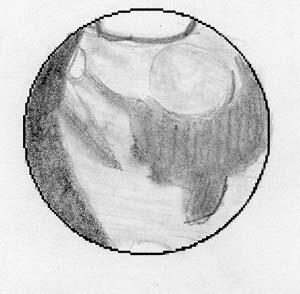
Sketched July 6, 2003 from my back deck at 4:30 a.m. pacific DST (daylight savings time) or 11:30 UT.
| Date: 07/06/03 Lat 27.6N, Long 122W, elev. 200 feet | Sketch Time (UT): 11:30, (local time): 4:30 a.m. DST |
| Central Meridian: 258° | Filters: none |
| Instrument: 4-inch (105mm) f/6 Astro-Physics Traveler Apo refractor. | Distance from earth 0.53 AU, 79.5m km, 49m miles |
| Magnification: 376x (4mm) Zeiss Abbe Ortho, and 2.4x AP Barcon Barlow | Transp. 4/6, Seeing 9/10, Antoniadi (I-V): I |
| Apparent Size: 17.6" | Magnitude: -1.6 |
South Polar cap (top) is ringed with a dark melt line, the area of Martian earth uncovered as the polar cap receeds. Below the south polar cap (north and to the right) is Hellas, the great crater which was the source of a dust storm, which changed the color of the area. I noticed the lighter area of Hellas, but had not really looked at it in past oppositions to compare for dust. Luckily the dust has abated since.
Dark areas: Below Hellas is a large feature made up of several areas. The northern (lowest) "hook" is Syrtis Major. When most people see a feature on Mars through their telescope it is this feature. It reminds alot of people of the continent Africa on earth because of its shape. Mare Hadriacum, Tyrrhenum and Serpentis are the dark features between Syrtis Major and Hellas.
Mare Cimmerium is the "slash" of dark on the left. The little spot at the bottom (north) is not the North Polar cap. It is facing away from us and not visible. What you see is Elysium.
Mars, in this sketch is reversed N/S. South is shown at the top of the image. The south polar cap is the prominent feature. Terminator is where daylight ends and evening begins. The terminator is on the left and the planet is rotating left to right. In my sketches the planet rotates martian east (left) to west (right) to match most other images and sketches. Look for features rotating from left to right in the drawings.
Details about Mars: Diameter 17.6 arc seconds(Jupiter is about 30 -50 arc seconds in diameter depending on its distance from earth). Central Meridian 258 - the imaginary line passing through the planetary poles of rotation and bisecting the planetary disk, and is used to determine the longitude during an observing session.

White Oaks Home | Sketches Index | Mars 2003 Index | Back | Next